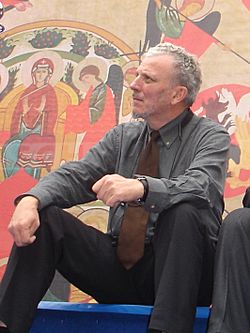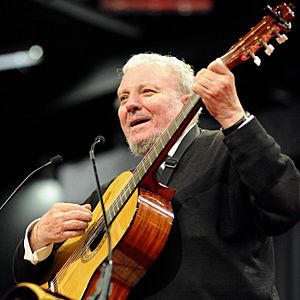Kiko Argüello facts for kids
Quick facts for kids
Kiko Argüello
|
|
|---|---|

Kiko Argüello at a Vocational Meeting
|
|
| Born | January 9, 1939 León, Castilla y León, Spain
|
| Nationality | Spanish |
| Alma mater | Real Academia de Bellas Artes de San Fernando |
Francisco José Gómez de Argüello y Wirtz (born January 9, 1939), known as Kiko Argüello, is a Spanish artist. He is famous for starting the Neocatechumenal Way along with Carmen Hernández and Father Mario Pezzi. This movement helps people learn more about the Catholic faith.
Contents
Who is Kiko Argüello?
Kiko Argüello is a very important person in the Catholic Church. He helped create a special path for people to grow in their faith. This path is called the Neocatechumenal Way.
Early Life and Art
Kiko Argüello was born in León, Spain. He loved art from a young age. He studied fine arts at the Royal Academy of San Fernando in Madrid. In 1959, he even won a special national award for his painting.
In 1964, Kiko started the Neocatechumenal Way. He began this work in a poor area of Madrid called Palomeras Altas.
A Big Change in His Life
Even though Kiko was a successful artist, he felt very confused and unhappy inside. He wondered why there was so much unfairness in the world. He also wondered what the point of life was. He felt like nothing made him truly happy.
During this difficult time, Kiko read about different ideas. He then realized that life was not meaningless. He felt that God existed and that God loved him. He also felt that this God was Jesus Christ, as taught by the Catholic Church.
After this important discovery, Kiko decided to dedicate his life to Jesus and the Church. He left his art career and went to live among the poorest people. He lived in a simple wooden shack in Palomeras Altas, carrying only his guitar, a crucifix, and a Bible. He wanted to help others find hope and faith.
Starting the Neocatechumenal Way
While living among the poor in Palomeras, Kiko met Carmen Hernández. She was a smart woman who had studied chemistry and theology. They also met a priest named Farnés Schrerer. Together, they were inspired by the changes happening in the Church after the Second Vatican Council. They decided to work together to help people learn about their faith.
The Neocatechumenal Way Today
The Neocatechumenal Way has grown a lot since it started. It has been active for over 30 years in more than 100 countries. Pope John Paul II recognized it as a good way for Catholics to learn and grow.
Today, Kiko Argüello, Maria Ascension, and Father Mario Pezzi lead the Neocatechumenal Way around the world. The Church officially approved its rules in 2008. Now, the Neocatechumenal Way is in over 110 countries. It is in nearly 900 dioceses and about 8,000 parishes. More than 30,000 communities are part of it.
Many Catholic universities have given Kiko Argüello special awards called honorary degrees. These awards recognize his important work. For example, he received a degree for helping families and for promoting family events. He also received one for helping the Church grow after the Second Vatican Council. In 2015, he and Carmen Hernández received another award. This was for their dedication to helping the poor and bringing people closer to Christ.
Kiko's Art and Church Designs
Kiko Argüello is also a talented artist. He has painted many religious artworks in churches and cathedrals around the world. He also writes religious songs for use in Neocatechumenal Way celebrations.
His art has brought a new look to churches. He has designed buildings, music, and decorations. In Rome, he painted large murals in several churches. He also designed the International Centre for the New Evangelisation in Porto San Giorgio, Italy. There, he created a huge cross and an abstract painting of the Creation.
Kiko has also designed many of the Redemptoris Mater Seminaries. These are places where people study to become priests. He designed centers in places like Newark and Denver in the USA, and Rome and Macerata in Italy.
In Florence, Italy, he painted a special artwork behind an altar. He also helped design a building for Neocatechumenal communities and the local diocese. In Piacenza, Italy, he painted one of the largest murals in the world. It shows the glory of Christ Pantocrator, who is Christ as the ruler of all.
In Madrid, Spain, Kiko designed several church buildings. He painted different religious scenes in churches like El Transito and Saint Joseph. He also designed and painted a chapel dedicated to Pentecost at La Paloma church. At Saint Catherine Labouré church, he designed the building and painted the story of Salvation. In Zamora, he painted a round mural showing the Birth of Jesus, his Baptism, and his Resurrection.

In Oulu, Finland, Kiko helped design the very first Roman Catholic parish church in that area.
In Israel, he helped design the large Domus Galilaeae building. This center is for biblical studies and welcomes pilgrims. Kiko painted a "Last Judgement" artwork that decorates the church there.
In 2004, Kiko was asked to paint the inside of the Almudena Cathedral in Madrid. He also replaced the stained glass windows before a royal wedding. His work in the cathedral has been very famous.
See also
 In Spanish: Kiko Argüello para niños
In Spanish: Kiko Argüello para niños




